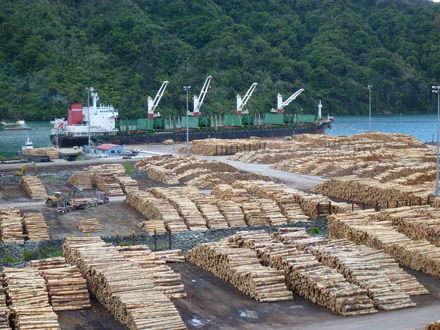
Plans are being put in place in New Zealand to increase methyl bromide monitoring following a theoretical modelling report about how the log fumigant disperses into the environment after use. This is additional monitoring, over and above the routine monitoring that industry is required to carry out every time methyl bromide fumigation occurs. Source: Timberbiz
Methyl bromide is a highly effective fumigant used to control quarantine pests. It is used in primary products for export, such as logs and fruit, and in imported industrial and agricultural goods.
Methyl bromide is a controlled substance under the Montreal Protocol on Substances that Deplete the Ozone Layer. Use of methyl bromide for quarantine and pre-shipment purposes (QPS) is exempted from controls under the Montreal Protocol, but countries are encouraged to reduce and replace it.
The mathematical modelling of operations at the Port of Tauranga was commissioned by the Environmental Protection Authority (EPA) as part of a modified reassessment currently underway to review the rules around methyl bromide use.
This modified reassessment is a statutory process where an independent decision-making committee considers evidence in relation to the way methyl bromide is used. The additional monitoring, to be carried out by WorkSafe, will feed into that process.
The Ministry of Health is maintaining a watching brief on the monitoring program and stresses there is no immediate public health concern.
“We know New Zealanders are concerned about methyl bromide use so it’s important that we get accurate data on which to base our decisions,” Gayle Holmes, Acting GM of the EPA’s Hazardous Substances Group said.
“Our mathematical modelling report conflicts with that put forward by industry as part of the current reassessment process, and others undertaken when methyl bromide was last reassessed in 2010. It is also at odds with routine monitoring data which industry is required to undertake whenever methyl bromide is used at ports around New Zealand
of computer modelling.”
Data from the tests will fill the gap between what the modelling reflects and what can be detected in the air; it will track the chemical’s dispersal patterns and concentration levels. This additional data will then be considered by the EPA Decision-making Committee which is responsible for deciding if changes are needed to the rules around methyl bromide use.
The mathematical modelling report, subsequent peer review and all other related information being put forward as evidence to inform the modified reassessment of methyl bromide is publicly available on the EPA’s website.
The EPA’s Decision-making Committee considering the modified reassessment of methyl bromide announced the public hearings planned for December will be deferred to the new year so that this additional monitoring data can be taken into account.







